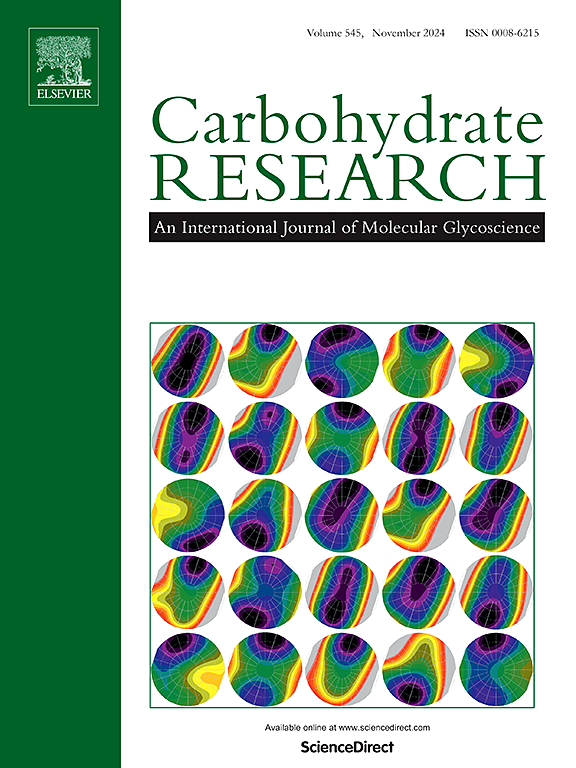1H NMR studies of molecular interaction of d-glucosamine and N-acetyl-D-glucosamine with curcumin and caffeic acid phenethyl ester in DMSO
IF 2.5
3区 化学
Q3 BIOCHEMISTRY & MOLECULAR BIOLOGY
引用次数: 0
Abstract
Chitosan (Cs)-based polymers have been explored as potential drug-delivery systems that could enhance the practical applications of bioactive phenolic (Ph) substances, such as curcumin (CUR) and caffeic acid phenethyl ester (CAPE). In this study, we focused on designing CS-based drug carriers by examining the intermolecular interactions between the polymer components, d-glucosamine (Gn) and N-acetyl-d-glucosamine (AGn), and the target substances CUR and CAPE through 1H NMR titration in dimethyl sulfoxide (DMSO‑d6). The observed changes in chemical shifts indicated that Gn cation (GnH+) forms molecular complexes, whereas AGn does not exhibit any intermolecular interaction. We developed a titration curve for the complexation, which competes with the self-association of GnH+ (Gnz) in DMSO. Least-squares analyses concluded that molecular complex represented as Ph·Gnz (z = 3 or 4) is formed through a reaction between a Gnz aggregate and a Ph molecule. The formation constant, K = [Ph·Gnz]/[Ph][Gnz], falls within the range of 50–300 M−1. The complex is stabilized by intermolecular interactions at multiple sites within the glucosamine aggregate Gnz, although the non-covalent interactions at each binding site are relatively weak. These findings suggest that chitosan can capture CAPE or CUR exclusively at segments composed of adjacent cationic glucosamine units.

DMSO中d-氨基葡萄糖和n -乙酰- d-氨基葡萄糖与姜黄素和咖啡酸苯乙酯分子相互作用的1H NMR研究。
壳聚糖(Cs)基聚合物作为潜在的药物递送系统,可以增强姜黄素(CUR)和咖啡酸苯乙酯(CAPE)等生物活性酚类物质的实际应用。在本研究中,我们重点设计了基于cs的药物载体,通过1H NMR滴定法研究了聚合物组分d-氨基葡萄糖(Gn)和n -乙酰-d-氨基葡萄糖(AGn)与靶物质CUR和CAPE在二甲亚砜(DMSO - d6)中的分子间相互作用。观察到的化学位移变化表明,Gn阳离子(GnH+)形成分子复合物,而AGn不表现出任何分子间相互作用。我们开发了一个络合滴定曲线,它与GnH+ (Gnz)在DMSO中的自结合相竞争。最小二乘分析得出,分子复合物表示为Ph·Gnz(z = 3或4),是由Gnz聚集体与Ph分子之间的反应形成的。形成常数K = [Ph·Gnz]/[Ph][Gnz]在50-300 M-1之间。该复合物通过葡萄糖胺聚集体Gnz内多个位点的分子间相互作用来稳定,尽管每个结合位点的非共价相互作用相对较弱。这些发现表明,壳聚糖可以捕获由相邻阳离子氨基葡萄糖单元组成的片段上的CAPE或CUR。
本文章由计算机程序翻译,如有差异,请以英文原文为准。
求助全文
约1分钟内获得全文
求助全文
来源期刊

Carbohydrate Research
化学-生化与分子生物学
CiteScore
5.00
自引率
3.20%
发文量
183
审稿时长
3.6 weeks
期刊介绍:
Carbohydrate Research publishes reports of original research in the following areas of carbohydrate science: action of enzymes, analytical chemistry, biochemistry (biosynthesis, degradation, structural and functional biochemistry, conformation, molecular recognition, enzyme mechanisms, carbohydrate-processing enzymes, including glycosidases and glycosyltransferases), chemical synthesis, isolation of natural products, physicochemical studies, reactions and their mechanisms, the study of structures and stereochemistry, and technological aspects.
Papers on polysaccharides should have a "molecular" component; that is a paper on new or modified polysaccharides should include structural information and characterization in addition to the usual studies of rheological properties and the like. A paper on a new, naturally occurring polysaccharide should include structural information, defining monosaccharide components and linkage sequence.
Papers devoted wholly or partly to X-ray crystallographic studies, or to computational aspects (molecular mechanics or molecular orbital calculations, simulations via molecular dynamics), will be considered if they meet certain criteria. For computational papers the requirements are that the methods used be specified in sufficient detail to permit replication of the results, and that the conclusions be shown to have relevance to experimental observations - the authors'' own data or data from the literature. Specific directions for the presentation of X-ray data are given below under Results and "discussion".
 求助内容:
求助内容: 应助结果提醒方式:
应助结果提醒方式:


